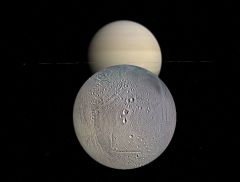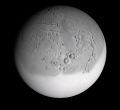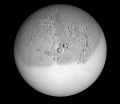Enceladus
Jump to navigation
Jump to search
| Enceladus | |
|---|---|

| |
| Enceladus in Orbiter 2016 with D3D9 client with Saturn in the background | |
| Designation | |
| Name | Enceladus |
| Reference body | Saturn |
| Planetary mean orbits | |
| Epoch | 1999 |
| Semimajor axis (a) | 238000000 m |
| Eccentricity (e) | 0.0001 |
| Inclination (i) | 0.009998° (1.745×10-4 radian) |
| Longitude of the ascending node (LAN, ☊) | 137.0515046° (2.392 radian) |
| Longitude of periapsis (ϖ) | 111.7840658° (1.951 radian) |
| Mean longitude (L) | 273.8165303° (4.779 radian) |
| Selected physical parameters | |
| Mean radius | 249000 km |
| Mass | 7.30×1019 kg |
| Rotation elements | |
| SidRotPeriod | 118454 seconds (32.9 hours) |
| SidRotOffset | 0 |
| Obliqutiy | 0.4895 |
| LAN | 6.09808 |
| Note | *Elements given are from Enceladus.cfg (osaturn.zip) |
Enceladus is sixth largest moon of Saturn, and the nineteenth largest moon in the Solar System, about 500 km diameter, about a tenth the diameter of Titan. It was discovered by William Herschel on 28 August 1789. Enceladus has been imaged by Voyagers 1 and 2 and by the Cassini mission.
Enceladus in Orbiter
Enceladus was introduced by the release of Orbiter 2002.
Orbiter versions and add-ons which include Enceladus.
| Add-on | Source | Version | Author | Type | Release Date | Compatibility | Wiki article |
|---|---|---|---|---|---|---|---|
| Orbiter 2003-P2 | O-F Resources | 031217 | martins | Orbiter Download | 17 December 2003 | Orbiter 2003-P2 | |
| Orbiter 2003-P1 | O-F Resources | 031105 | martins | Orbiter Download | 5 November 2003 | ||
| Moons of Saturn Part 3 | AVSIM | Rolf Keibel | Scenery | 19 October 2002 | |||
| Orbiter 2002 | O-F Resources | 020419 | martins | Orbiter Download | 19 April 2002 | Orbiter 2002 | |
See also
| edit The Solar System | |
|---|---|
| Central star |
Sun (Sol) |
| Planets |
Mercury - Venus - Earth - Mars - Jupiter - Saturn - Uranus - Neptune |
| Natural satellites |
Moon - Phobos - Deimos - Io - Europa - Ganymede - Titan - more... |
| Add-ons |
Planets - Dwarf Planets - Small objects - Natural satellites - Alternative star systems |
 | This natural satellite related article is a stub. You can help Orbiterwiki by expanding it. |



